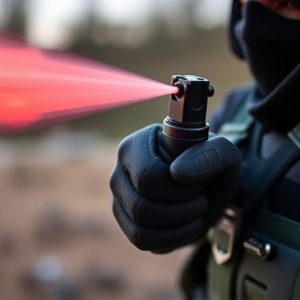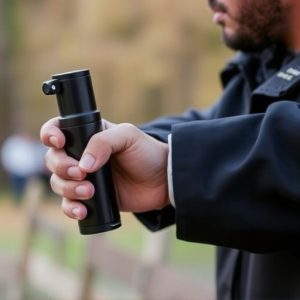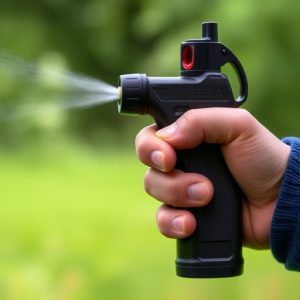Choosing Effective Pepper Spray for Personal Safety: A Comprehensive Guide
When considering pepper spray as a personal defense mechanism, it's crucial to understand its …….
When considering pepper spray as a personal defense mechanism, it's crucial to understand its mechanics and effects, which include causing temporary blindness and incapacitation through eye, skin, and respiratory irritation using capsaicin. Selecting the appropriate type of pepper spray—foam, gel, or liquid—with an effective OC concentration, typically at least 10%, is essential, along with considering canister volume and adhering to state laws. Opt for reputable brands that comply with industry standards. Additionally, familiarize yourself with how to deploy the spray effectively. When purchasing, evaluate the delivery system's suitability for your needs, whether it's for everyday carry or specific defense scenarios, and consider factors like capacity, usability under stress, legal compliance, and personal preferences such as UV marking dye. It's also important to ensure a long shelf life and simple maintenance of the pepper spray. Remember that adequate training is necessary for effective use, and laws regulating pepper spray vary by location, so always verify local regulations to avoid legal penalties. Knowledgeable retailers can guide you in selecting a compliant product and may offer information on authorized training courses. The harmony of choosing the right product, gaining knowledge through training, and understanding the legal constraints will ensure that pepper spray is an effective tool for personal defense.
When considering non-lethal self-defense options, understanding the role and effectiveness of pepper spray is crucial. This article delves into the science behind pepper spray’s potent defensive properties, guiding readers on how to buy the right pepper spray for their personal safety needs. We explore its mechanism, effects, and the key factors that influence its selection. Furthermore, we navigate the market, offering tips to choose the best pepper spray available. Additionally, we address training and legal considerations essential for prepared and lawful use in self-defense scenarios. With the right information and tools, pepper spray can be an effective deterrent against potential threats.
Understanding Pepper Spray: An Overview of Its Mechanism and Effects
When considering personal safety measures, understanding the mechanism and effects of pepper spray is crucial. Pepper spray, also known as OC (oleoregonium) spray, is a non-lethal self-defense tool that temporarily incapacitates an attacker by causing irritation to their eyes, skin, and respiratory system. The active ingredient in pepper spray, capsaicin, derived from chili peppers, triggers a strong reaction upon contact with mucous membranes. This response results in a sudden burning sensation, intense coughing, and short-term blindness, effectively deterring an assailant.
For effective personal protection, it’s important to buy the right pepper spray that suits your needs. Factors such as the concentration of oleoresin capsicin, the type of spray (e.g., foam, gel, or liquid), and the volume of the canister are key considerations. Additionally, state laws dictate the legality and restrictions on pepper spray ownership, so it’s imperative to research and comply with these regulations when purchasing. Keychain models are popular for their accessibility, while larger cans may offer greater range. Always ensure that the pepper spray you choose has a clear safety training guide, as understanding how to deploy it correctly is as important as having it on hand. When buying, look for reputable brands and retailers who provide transparent product information and certifications, ensuring that the pepper spray meets industry standards for effectiveness and safety.
Key Factors to Consider When Selecting the Right Pepper Spray for Personal Safety
When selecting the right pepper spray for personal safety, it’s crucial to consider several key factors to ensure effectiveness and legal compliance. Firstly, the concentration of the active ingredient, oleoresin capsicum (OC), is a primary determinant of its potency. Higher concentrations generally translate to greater disorientation effects, with models ranging from 5% to 20% strength. The choice between these strengths should be informed by your familiarity with the product, as high concentrations might be more effective for those experienced with pepper spray, due to their ability to respond appropriately in a critical situation.
Additionally, the delivery mechanism is another significant aspect. Pepper sprays come in various forms, including keychain models, gel formulations, and foam-like pepper mace. Gel and foam options can provide a longer range and more accurate aim compared to traditional sprays, which can be essential in crowded spaces or when trying to avoid collateral effects. Furthermore, consider the spray’s capacity; a larger volume of spray might offer a greater deterrent effect but could also make it heavier to carry consistently. Other factors to consider include the spray’s ease of use under stress, its legal status in your area, and whether you prefer a model with a finger grip for better control. How to buy the right pepper spray involves not just understanding these factors but also practicing with the product to ensure familiarity and confidence in its deployment. Always prioritize products that are compliant with local laws and regulations to avoid any legal repercussions, ensuring your personal safety tool is both effective and legally sound.
Navigating the Market: Tips on How to Buy the Best Pepper Spray for Your Needs
When considering pepper spray as a personal safety tool, it’s crucial to evaluate your specific needs and the scenarios in which you might use it. The market offers a variety of pepper spray products, each with unique features that cater to different situations. To buy the right pepper spray, start by assessing the intensity of the spray; higher concentration levels like OC (oleoresin capsicum) at 10% or more are generally more effective and legally permissible for self-defense. Additionally, consider the delivery system that suits you best, whether it’s a keychain model for everyday carry, a larger canister for extended range, or a discreet pocket spray for convenience. Check the spray’s capacity; a minimum of 25 bursts is recommended to ensure you have enough for a strong deterrent against an attacker. Safety features like UV marking dye to identify assailants post-incident are also valuable additions. Furthermore, look for pepper sprays with a long shelf life and easy maintenance. Reading customer reviews can provide insights into the product’s performance and reliability under pressure. By researching and understanding the differences between models, you can make an informed decision on the best pepper spray to fit your personal safety requirements. Remember to adhere to local laws and regulations regarding the purchase and use of pepper spray as self-defense tools, ensuring your choice is both compliant and effective for your protection.
Training and Legal Implications: Preparing for the Use of Pepper Spray in Self-Defense Situations
When considering pepper spray as a component of personal safety, it’s crucial to understand both the effective use of the product and the legal framework governing its application. Proper training is an indispensable aspect of using pepper spray effectively in self-defense situations. It’s not enough to simply buy the right pepper spray; users must also familiarize themselves with its deployment mechanisms, aiming techniques, and the circumstances under which its use is justified. Training programs often cover scenarios where pepper spray could be employed, providing practical experience that can be critical in an actual confrontation. Moreover, understanding the legal implications is equally important; laws vary by jurisdiction, dictating where and how pepper spray can be carried and used. In some regions, there are restrictions on the strength of pepper spray available for civilian purchase, and specific guidelines on where it may be legally prohibited. For instance, certain establishments, like schools or places of employment, might have regulations against bringing pepper spray onto their premises. Prospective buyers must research local laws to ensure compliance and avoid potential legal repercussions. By combining the right product with responsible training and a thorough understanding of legal constraints, individuals can better prepare themselves for scenarios where personal safety may be at risk. Knowledgeable retailers can guide consumers on how to buy the right pepper spray that aligns with local laws and provide information on reputable training courses, ensuring users are well-equipped in both knowledge and skill for their personal safety needs.


